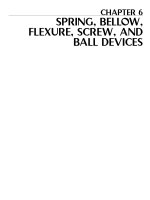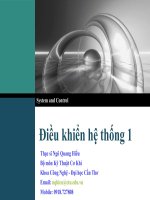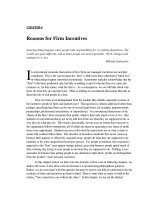CHAPTER 5 Macros and subprograms - CHAPTER 6 Examples for subsystems within microcontroller potx
Bạn đang xem bản rút gọn của tài liệu. Xem và tải ngay bản đầy đủ của tài liệu tại đây (191.42 KB, 23 trang )
CHAPT ER 5
Macros and subprograms
Introduction
5.1 Macros
5.2 Subprograms
5.3 Macros used in the examples
Introduction
Same or similar sequence of instructions is frequently used during programming.
Assembly language is very demanding. Programmer is required to take care of every
single detail when writing a program, because just one incorrect instruction or label
can bring about wrong results or make the program doesn't work at all. Solution to
this problem is to use already tested program parts repeatedly. For this kind of
programming logic, macros and subprograms are used.
5.1 Macros
Macro is defined with directive macro containing the name of macro and parameters
if needed. In program, definition of macro has to be placed before the instruction line
where macro is called upon. When during program execution macro is encountered,
it is replaced with an appropriate set of instructions stated in the macro's definition.
macro_name
macro par1,
par2,
set of instructions
set of instructions
endm
The simplest use of macro could be naming a set of repetitive instructions to avoid
errors during retyping. As an example, we could use a macro for selecting a bank of
SFR registers or for a global permission of interrupts. It is much easier to have a
macro BANK1 in a program than having to memorize which status bit defines the
mentioned bank. This is illustrated below: banks 0 and 1 are selected by setting or
clearing bit 5 (RP0) of status register, while interrupts are enabled by bit 7 of
INTCON register. First two macros are used for selecting a bank, while other two
enable and disable interrupts.
bank0 macro ; Macro bank0
bcf STATUS, RP0 ; Reset RP0 bit = Bank0
endm ; End of macro
bank1 macro ; Macro bank1
bsf STATUS, RP0 ; Set RP0 bit = Bank1
endm ; End of macro
enablein
t
macro ; Interrupts are globally enabled
bsf INTCON, 7 ; Set the bit
endm ; End of macro
disablein
t
macro ; Interrupts are globally disabled
bcf INTCON, 7 ; Reset the bit
endm ; End of macro
These macros are to be saved in a special file with extension INC (abbrev. for
INCLUDE file). The following image shows the file bank.inc which contains two
macros, bank0 and bank1.
Macros Bank0 and Bank1 are given for illustrational purposes more than
practical, since directive BANKSEL NameSFR does the same job. Just write
BANKSEL TRISB and the bank containing the TRISB register will be selected.
As can be seen above, first four macros do not have parameters. However,
parameters can be used if needed. This will be illustrated with the following macros,
used for changing direction of pins on ports. Pin is designated as input if the
appropriate bit is set (with the position matching the appropriate pin of TRISB
register, bank1) , otherwise it's output.
input macro par1, par2 ; Macro input
bank1 ; In order to access TRIS registers
bsf par1, par2 ; Set the given bit - 1 = input
bank0 ; Macro for selecting bank0
endm ; End of macro
outp
ut
macro par1, par2 ; Macro output
bank1 ; In order to access TRIS registers
bcf par1, par2 ; Reset the given bit - 0 = output
bank0 ; Macro for selecting bank0
endm ; End of macro
Macro with parameters can be called upon in following way:
output TRISB, 7 ; pin RB7 is output
When calling macro first parameter TRISB takes place of the first parameter, par1, in
macro's definition. Parameter 7 takes place of parameter par2, thus generating the
following code:
outp
ut
TRISB, 7 ; Macro output
bsf STATUS, RP0 ; Set RP0 bit = BANK1
bcf TRISB, 7 ; Designate RB7 as output
bcf STATUS, RP0 ; Reset RP0 bit = BANK0
endm ; End of macro
Apparently, programs that use macros are much more legible and flexible. Main
drawback of macros is the amount of memory used - every time macro name is
encountered in the program, the appropriate code from the definition is inserted.
This doesn't necessarily have to be a problem, but be warned if you plan to use
sizeable macros frequently in your program.
In case that macro uses labels, they have to be defined as local using the directive
local. As an example, below is the macro for calling certain function if carry bit in
STATUS register is set. If this is not the case, next instruction in order is executed.
callc macro label ; Macro callc
local Exit ; Defining local label within macro
bnc Exit ; If C=0 jump to Exit and exit macro
call label ; If C=1 call subprogram at the
; address label outside macro
Exit ; Local label within macro
endm ; End of macro
5.2 Subprograms
Subprogram represents a set of instructions beginning with a label and ending with
the instruction return or retlw. Its main advantage over macro is that this set of
instructions is placed in only one location of program memory. These will be
executed every time instruction call subprogram_name is encountered in program.
Upon reaching return instruction, program execution continues at the line succeeding
the one subprogram was called from. Definition of subprogram can be located
anywhere in the program, regardless of the lines in which it is called.
Lab
el
; subprogram is called with "call Label"
set of
instructions
set of
instructions
set of
instructions
return or retlw
With macros, use of input and output parameters is very significant. With
subprograms, it is not possible to define parameters within the subprogram as can
be done with macros. Still, subprogram can use predefined variables from the main
program as its parameters.
Common course of events would be: defining variables, calling the subprogram that
uses them, and then reading the variables which may have been changed by the
subprogram.
The following example, addition.asm adds two variables, PAR1 and PAR2, and stores
the result to variable RES. As 2-byte variables are in question, lower and higher byte
has to be defined for each of these. The program itself is quite simple; it first adds
lower bytes of variables PAR1 and PAR2, then it adds higher bytes. If two lower bytes
total exceeds 255 (maximum for a byte) carry is added to variable RESH.
Basic difference between macro and subprogram is that the macro
stands for its definition code (sparing the programmer from
additional typing) and can have its own parameters while
subprogram saves memory, but cannot have its own parameters.
5.3 Macros used in the examples
Examples given in chapter 6 frequently use macros ifbit, ifnotbit, digbyte, and
pausems, so these will be explained in detail. The most important thing is to
comprehend the function of the following macros and the way to use them, without
unnecessary bothering with the algorithms itself. All macros are included in the file
mikroel84.inc for easier reference.
5.3.1 Jump to label if bit is set
ifbit macro par1, par2, par3
btfsc par1, par2
goto par3
endm
Macro is called with : ifbit Register, bit, label
5.3.2 Jump to label if bit is cleared
ifnotbit macro par1, par2, par3
btfss par1, par2
goto par3
endm
Macro is called with : ifnotbit Register, bit, label
Next example shows how to use a macro. Pin 0 on port A is checked and if set,
program jumps to label ledoff, otherwise macro ifnotbit executes, directing the
program to label ledon.
5.3.3 Extracting ones, tens and hundreds from variable
Typical use for this macro is displaying variables on LCD or 7seg display.
digbyte macro par0
local Pon0
local Exit1
local Exit2
local Positive
local Negative
clrf Dig1
clrf Dig2
clrf Dig3
Positive
movf par0, w
movwf Digtemp
movlw .100
Pon0 incf Dig1 ;computing hundreds digit
subwf Digtemp
btfsc STATUS, C
goto Pon0
decf Dig1, w
addwf Digtemp, f
Exit1 movlw .10 ;computing tens digit
incf Dig2, f
subwf Digtemp, f
btfsc STATUS, C
goto Exit1
decf Dig2, f
addwf Digtemp, f
Exit2 movf Digtemp, w ;computing ones digit
movwf Dig3
endm
Macro is called with :
movlw .156 ; w = 156
movwf RES ; RES = w
digbyte
RES
; now Dec1<-1, Dec2<-5,
Dec3<-6
The following example shows how to use macro digbyte in program. At the
beginning, we have to define variables for storing the result, Dig1, Dig2, Dig3, as
well as auxiliary variable Digtemp.
5.3.4 Generating pause in miliseconds (1~65535ms)
Purpose of this macro is to provide exact time delays in program.
pausem
s
macro par1
local Loop1
local dechi
local Delay1ms
local Loop2
local End
movlw high par1 ; Higher byte of parameter 1 goes to HIcnt
movwf HIcnt
movlw low par1 ; Lower byte of parameter 1 goes to LOcnt
movwf LOcnt
Loop1
movf LOcnt, f ; Decrease HIcnt and LOcnt necessary
btfsc STATUS, Z
; number of times and call subprogram
Delay1ms
goto dechi
call Delay1ms
decf LOcnt, f
goto Loop1
dechi
movf HIcnt, f
btfsc STATUS, Z
goto End
call Delay1ms
decf HIcnt, f
decf LOcnt, f
goto Loop1
Delay1
ms:
; Delay1ms produces a one milisecond delay
movlw .100 ; 100*10us=1ms
movwf LOOPcnt ; LOOPcnt<-100
Loop2:
nop
nop
nop
nop
nop
nop
nop
decfsz LOOPcnt,
f
goto Loop2 ; Time period necessary to execute loop Loop2
return ; equals 10us
End
endm
This macro is written for an 4MHz oscillator. For instance, with 8MHz oscillator, pause
will be halved. It has very wide range of applications, from simple code such as
blinking diodes to highly complicated programs that demand accurate timing.
Following example demonstrates use of macro pausems in a program. At the
beginning of the program we have to define auxiliary variables HIcnt, LOcnt, and
LOPcnt.
CHAPT ER 6
Examples for subsystems within
microcontroller
Introduction
6.1 Writing to and reading from EEPROM
6.2 Processing interrupt caused by changes on pins RB4-RB7
6.3 Processing interrupt caused by change on pin RB0
6.4 Processing interrupt caused by overflow on timer TMR0
6.5 Processing interrupt caused by overflow on TMR0 connected to external input
(TOCKI)
Introduction
Every microcontroller comprises a number of subsystems allowing for flexibility and
wide range of applications. These include internal EEPROM memory, AD converters,
serial or other form of communication, timers, interrupts, etc. Two most commonly
utilized elements are interrupts and timers. One of these or several in combination
can create a basis for useful and practical programs.
6.1 Writing to and reading from EEPROM
Program "eeprom.asm" uses EEPROM memory for storing certain microcontroller
parameters. Transfer of data between RAM and EEPROM has two steps - calling
macros eewrite and eeread. Macro eewrite writes certain variable to a given address,
while eeread reads the given address of EEPROM and stores the value to a variable.
Macro eewrite writes the address to EEADR register and the variable to EEDATA
register. It then calls the subprogram which executes the standard procedure for
initialization of writing data (setting WREN bit in EECON1 register and writing control
bytes 0x55 and 0xAA to EECON2).
For data to be actually stored in EEPROM, 10ms delay is necessary. This is achieved
by using macro pausems. In case that this pause is unacceptable for any reason,
problem can be solved by using an interrupt for signaling that data is written to
EEPROM.
eewrite macro addr, var
addr Destination address. With PIC16F84, there are 68 bytes
of EEPROM for a total address range of 0x00 - 0x44.
var Name of the variable to be stored to EPROM
eeread macro addr, var
addr Destination address. With PIC16F84, there are 68 bytes
of EEPROM for a total address range of 0x00 - 0x44.
var
Name of the variable into which data read from EPROM will be
stored.
Example: Variable volume, which is set via buttons RA0 and RA1, will be stored to
the address 0 of EEPROM. After reboot, when the program is started, it first loads the
last known value of variable volume from EEPROM.
6.2 Processing interrupt caused by changes on pins
RB4-RB7
Program "intportb.asm" illustrates how interrupt can be employed for indicating
changes on pins RB4-RB7. Upon pushing any of the buttons, program enters the
interrupt routine and determines which pin caused an interrupt. This program could
be utilized in systems with battery power supply, where power consumption plays an
important role. It is useful to set microcontroller to low consumption mode with a
sleep instruction. Microcontroller is practically on stand-by, saving energy until the
occurrence of interrupt.
Example of processing interrupt caused by changes on pins RB4-RB7
6.3 Processing interrupt caused by change on pin RB0
Example "intrb0.asm" demonstrates use of interrupt RB0/INT. Upon falling edge of
the impulse coming to RB0/INT pin, program jumps to subprogram for processing
interrupt. This routine then performs a certain operation, in our case it blinks the
LED diode on PORTB, 7.
Example of processing interrupt caused by changes on pin RB0
6.4 Processing interrupt caused by overflow on timer
TMR0
Program "inttmr0.asm" illustrates how interrupt TMR0 can be employed for
generating specific periods of time. Diodes on port B are switched on and off
alternately every second. Interrupt is generated every 5.088ms; in interrupt routine
variable cnt is incremented to the cap of 196, thus generating approx. 1 second
pause (5.088ms*196 is actually 0.99248s). Pay attention to initialization of OPTION
register which enables this mode of work for timer TMR0.
Example of processing interrupt caused by overflow on timer TMR0
6.5 Processing interrupt caused by overflow on TMR0
connected to external input (TOCKI)
Counter TMR0 increments upon signal change on pin RA4/TOCKI. Prescaler is set to
4, meaning that TMR0 will be incremented on every fourth impulse. Pay attention to
initialization of OPTION register which enables this mode of work for timer TMR0
(this mode is common for devices such as counters).
Example of processing interrupt caused by overflow on timer TMR0
connected to TOCKI









